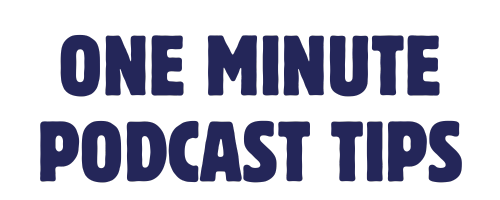Episode 133
4 Quick Editing Tips for Real-world Podcast Listening
When you edit for where your listeners actually are - and not where you wish they were - you create a better experience for them.
Products I Use for One Minute Podcast Tips
Note: these may contain affiliate links, so I get a small percentage of any product you buy when using my link.
My equipment:
- RODE NT1-A large diaphragm condenser mic
- Rodecaster Pro II audio production studio
- Sony MDR-7506 Studio Monitor Headphones
- Elgato Wave Mic Arm Low Profile
Recommended resources:
- Captivate.fm podcast hosting, distribution, analytics, and monetization
- Kit email marketing
- Boomcaster remote recording and live streaming
- Hindenburg Pro recording and editing
- Auphonic AI assistant for audio post production
- Fourthwall merch stores for creators
One Minute Podcast Tips is a podcast education show brought to you by Danny Brown.
If you enjoy the show, I'd love for you to leave a rating or review on your favourite podcast app!
And please let your friends and other podcasters know they can listen for free on Spotify and Apple Podcasts, as well as their preferred podcast app, or online at One Minute Podcast Tips.
Winner of the Best Podcast Tips Podcast in the 2024 Ear Worthy Independent Podcast Awards.
Mentioned in this episode:
Join the One Minute Podders membership for exclusive perks!
You're a serious indie podcaster looking to go beyond the one minute tips offered in each episode. You want to connect with like-minded podcasters as well as ask your own specific questions. Perfect - the One Minute Podders membership is just for you, with invite-only monthly live streams, early access to episodes 48 hours before anyone else, and a link to your podcast in the show notes.
Support One Minute Podcast Tips
Recommend the show
Help your friends and other podcasters discover One Minute Podcast Tips, by sharing/recommending this episode and/or the show with them!
This podcast uses the following third-party services for analysis:
OP3 - https://op3.dev/privacy
Transcript
When we talk about podcast editing, most of us are thinking about one thing. How do I make this sound good? And that's absolutely the right instinct.
But the definition of good can change depending on how your audience is actually consuming your podcast. The reality is your listeners aren't always sitting in a quiet room with studio headphones on.
Some of the ways people consume podcasts are smartphones on the move when they're commuting, walking the dog, etc. Bluetooth speakers or smart speakers and car stereos, which can mean the listening environment isn't perfect.
So to ensure that your audio comes across as best as it can, here's some of the ways to edit your podcast based on how people are actually listening. Prioritize vocal clarity above all else. After all, if your voice isn't cutting through, nothing else matters.
So use EQ to carve out some space for your vocals, a gentle low cut to remove rumble, some upper mid presence to add clarity, and smooth any harsh sibilance with some light de essing. Make sure you keep dynamic range tight but not flat.
This just means using light compression to even things out and making sure your audio sounds natural and non fatiguing. Watch your noise floor.
Background noise that seems minor in your recording and error in a space can get really noticeable on car speakers or smart speakers. So use noise reduction, but use it carefully enough to clean things up, but not so much that it introduces artifacts.
But I guess most of all, don't obsess over perfection. A well edited podcast doesn't need to be a sterile one.
Minor breaths, natural pauses and authentic delivery can actually make for a more enjoyable listening experience. It's not about chasing perfection, it's about clarity, consistency and making sure your content shines no matter how or where it's being heard.
When you edit for where your listeners actually are and not where you wish they were, you create a better listening experience for them, which is never a bad thing. Until the next time. Happy podcasting.






